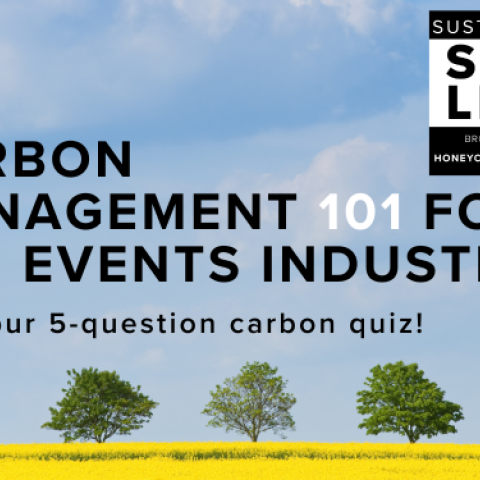Carbon Management 101 for the Events Industry

Exclusively sponsored by Honeycomb Strategies.
Start here: Take our 5-question carbon quiz! Test what you already know about carbon emissions, then scroll down to read more about our answers.
1. Freight logistics
Question: Which method of shipping to an event is the most carbon intense?
Correct Answer: Airplane.
This answer may not surprise you, but maybe you don’t know about the alternatives. Freight via container ship is 94% less carbon-intensive than air, and rail shipping is even less, though they require more transit time. For final-mile transportation, local electric fleets and consolidated shipments lower freight emissions.
Ordering and building locally is a great choice, however, if that means that you’re going to dispose of constructed materials or furniture after one use and build it again next time, it won’t help your carbon footprint by much (see question 3). Building low-profile with durable, lightweight materials that pack easily will also reduce your costs as well as your emissions profile.
The takeaway: Build low-pro, rent or buy locally near your event, consolidate shipments, ship freight via train or container ship when possible.
*Source: Net Zero Carbon Events Logistics Guideline.
2. Food Procurement
Question: Rank the following foods in order from highest-carbon emitting to lowest-carbon emitting (excluding their transportation, refrigeration and preparation).
Correct Answer: 1-Beef, 2-Lamb, 3-Chocolate, 4-Farmed shrimp/prawns, 5-outdoor-grown tomatoes.
Deforestation is a major common factor for the four of the five foods on this list. Forests are cleared to make pasture for grazing animals, jungle in South America and Africa is clear-cut to plant cocoa beans and mangrove forests, which have other magnificent properties like controlling erosion and creating animal habitats, are destroyed to make shrimp farms. Remember: trees remove carbon from the atmosphere. When they are obliterated, not only does it prevent future carbon-capture, but it releases all the previously captured carbon into the atmosphere.
In contrast, 1 kg of beef is 200 times more carbon intensive than 1 kg of outdoor-grown tomatoes. That’s because produce captures carbon (anything with green leaves goes through photosynthesis) and uses less resources to grow. Vegetable farms can still contribute to fertilizer emissions, so buy organic when feasible.
In the full picture of catering for an event, transportation, preparation, refrigeration and disposal all have impacts. But starting at the root, food sources matter.
The takeaway: Source local, seasonal, fresh (not frozen), plant-based foods for most catering needs.
*Sources: Popular Science https://www.popsci.com/chocolate-carbon-emissions/; Net Zero Carbon Events Food and Food Waste Guidance
3. Waste Management
Question: Which form of waste is the highest carbon emitter?
Answer: Municipal Solid Waste, by a large margin.
Compost produces about half as much carbon impact as recycling, which is still only about 4.5% of the impact of landfill. Landfills release methane through decomposition, which traps more heat from the sun than carbon dioxide, increasing global warming.
The Greenhouse Gas Protocol lays out the procedure for defining the boundary for a life-cycle evaluation of a product from its natural form to end-of-life; a product’s method of disposal is not the only factor in selecting low-carbon materials, but it is a significant one.
The takeaway: Have end-of-life plans for all procured materials, invest in a comprehensive waste management strategy.
*Sources: 2020 UK Government Conversion Factors for greenhouse gas (GHG) reporting, National Institutes of Health
4. Signage Procurement
Question: Which sign carries the lowest carbon footprint?
Correct Answer: Falconboard OR Digital, depending on a number of factors.
So much goes into a materials decision like this, that both options can be part of a sustainability strategy.
If signage is dated or branded for one year only, use digital so you don’t have the footprint of the waste disposal after just one use. If the energy at the venue is sourced from renewables, and the tech you’re using is efficient (like LED screens) it makes digital a doubly good option.
For any printed signage, falconboard (aka honeycomb) is going to be the best bet, both because it’s easily recyclable, and its manufacture doesn’t include the extraction and processing of petroleum-based products like vinyl. But keep in mind that nearly 40% of all trees harvested are used to make paper products. Considering the negative effects to biodiversity and climate change from deforestation, falconboard should always include recycled content.
Chemicals, emissions from manufacture, and GHG dispersed in landfills are the reason why vinyl banners and foamcore signage are the absolute worst choices for printed signage–despite their popularity. By some estimates, polystyrene (foam) takes up to 30% of the space in landfills and takes 500 years to break down.
The takeaway: Design for reuse, consider end-of-life plans, integrate all your departments using smart data (like considering venue energy when making signage choices).
*Sources: NZCE Smart Production and Waste Management Guidance, World Wildlife Fund, FSC
5. Offsets
Question: Select the recommended criteria for evaluating the effectiveness of any carbon offset project:
Answer: All of the above.
Let’s be clear: reduction first. However, offsets for carbon emissions are a necessary part of carbon management until future technologies render certain components of event production – like air travel – carbon neutral. To make responsible decisions about investing in offsets, all of the above criteria should be considered in consultation with an expert.
The takeaway: As part of a comprehensive strategy that prioritizes carbon reduction, offsets should be judiciously reviewed and employed for unavoidable emissions.
*Source: NZCE Offsetting Guide
How’d You Do?
Carbon management is a complex field of interlocking strategies. By increasing our literacy in all areas of sustainability, we’re able to make more responsible decisions for our events. Instead of being overwhelmed by the vast scope of what it takes to reach net zero carbon, start where you are and make adjustments in line with a defined strategy, then measure your progress. For more, we recommend the guides published by Net Zero Carbon Events.
Honeycomb Strategies specializes in impactful solutions for sustainable events and venues. hcsustainability.com/ hello@hcssustainability.com


Add new comment